
Want to discover the best things to do in Jeju Island?
Jeju Island, a volcanic island off the coast of South Korea, stands as a majestic blend of natural beauty and cultural richness.
Known for its iconic Hallasan Mountain, expansive green tea fields, and the distinctive haenyeo (female divers), Jeju offers a glimpse into a unique Korean lifestyle that thrives amidst its volcanic landscapes.
This island is not just a haven for adventurers and nature lovers; it is also steeped in folklore and traditions that are encapsulated in local festivals and daily life.
As September rolls around, Jeju Island transforms into one of the best islands to visit.
The month brings with it a milder climate and the vibrant colors of early autumn, making it an ideal time for exploring the island’s natural wonders without the harsh summer heat or the busy tourist crowds.
Whether it’s hiking up the serene trails of Hallasan, strolling along the picturesque beaches, or participating in local harvest festivals, September in Jeju is a month that combines pleasant weather with rich cultural experiences.
In this article, we will explore the top 10 activities that make Jeju Island the best island to visit in September, each offering a unique way to connect with the island’s enchanting spirit and scenic beauty.
1. Visit Hallasan National Park
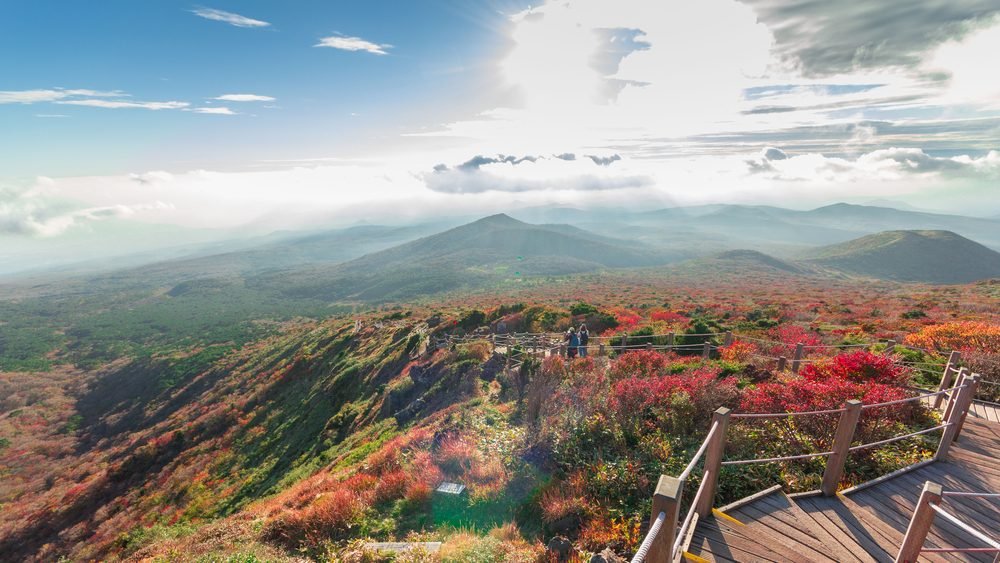
Hallasan stands as a proud centerpiece of Jeju Island, not merely for its status as the highest mountain in South Korea but as a shield volcano with a beautifully serene crater lake at its summit.
Designated a national park in 1970, Hallasan is not only a natural monument but also a cultural treasure, steeped in the myths and legends of Jeju Island.
The mountain is visible from all parts of Jeju, providing a constant reminder of nature’s prowess and beauty.
Hiking Opportunities and Scenic Beauty in September
September offers some of the best weather conditions for hiking Hallasan.
The cooler temperatures and reduced humidity make it an ideal time for both casual visitors and avid hikers to tackle the trails. Hallasan features two main hiking routes: Seongpanak and Gwaneumsa.
Seongpanak Trail leads to the summit and is longer but less steep, making it suitable for most fitness levels.
It meanders through lush landscapes, offering hikers a chance to witness the gradual change of seasons and the vibrant autumnal colors beginning to peek through the dense greenery.
Gwaneumsa Trail, on the other hand, is shorter but more challenging, presenting steeper ascents which reward hikers with more dramatic views of the volcanic rock formations and the densely wooded paths.
Both trails are well-maintained and offer numerous rest stops with breathtaking views that are particularly stunning in the early fall light.
Hiking Hallasan in September also presents a unique opportunity to see a variety of flora transitioning into the autumn season.
The mountain’s slopes are a riot of colors with alpine plants and the deciduous trees beginning to don their autumn leaves.
Wildlife, too, is more visible as the cooler weather brings them into the open, enhancing a hiker’s experience.
By visiting Hallasan National Park, travelers can fully appreciate why Jeju Island is considered the best island to visit in September.
The combination of pleasant weather, fewer tourists, and the natural scenery of Hallasan during this month truly makes it a hiker’s paradise.
2. Explore Jeju Folk Village Museum
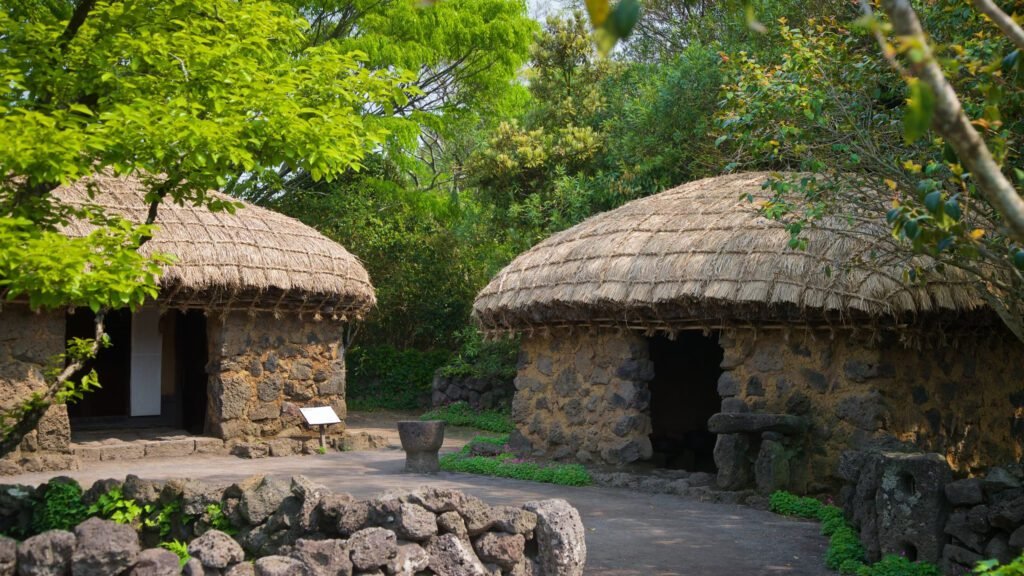
The Jeju Folk Village Museum serves as a vivid tableau of Jeju’s rich heritage and traditional life.
Located in the southern part of the island, this open-air museum meticulously recreates a traditional Jeju village from the 19th century, complete with over 100 restored buildings and structures.
This includes thatched houses, a Confucian school, government offices, and various workshops, providing visitors with a comprehensive insight into the daily lives of Jeju’s ancestors.
The museum not only showcases the architectural styles of the period but also highlights the unique matriarchal family structure of Jeju, distinct from the rest of Korea.
Through its extensive collection of artifacts and exhibits, the museum plays a crucial role in preserving and demonstrating the island’s distinct cultural practices, tools, and customs that have shaped the life and history of its people.
What to Expect When Visiting in September
Visiting the Jeju Folk Village Museum in September is particularly rewarding because of the engaging cultural events and special tours that coincide with the harvest season.
This time of the year, the museum often hosts traditional folk games and performances, such as horseback riding shows and folk music, allowing visitors to experience the cultural vibrancy of Jeju firsthand.
Special tours in September may include demonstrations of traditional farming techniques or food preparation methods, reflective of the season’s significance in agricultural production.
Visitors can participate in or observe the making of Jeju’s traditional foods, such as pheasant dishes and barley bread, which are linked to the island’s autumnal festivals and rituals.
The cooler, pleasant weather in September enhances the experience, making it comfortable for visitors to stroll through the extensive grounds of the museum.
The lush surroundings begin to showcase the early signs of autumn, providing a beautiful backdrop to the rich cultural explorations within the museum.
For those considering a trip to Jeju, the museum offers a deep dive into the island’s cultural heritage, making it clear why Jeju is acclaimed as the best island to visit in September.
3. Relax at Hyeopjae Beach
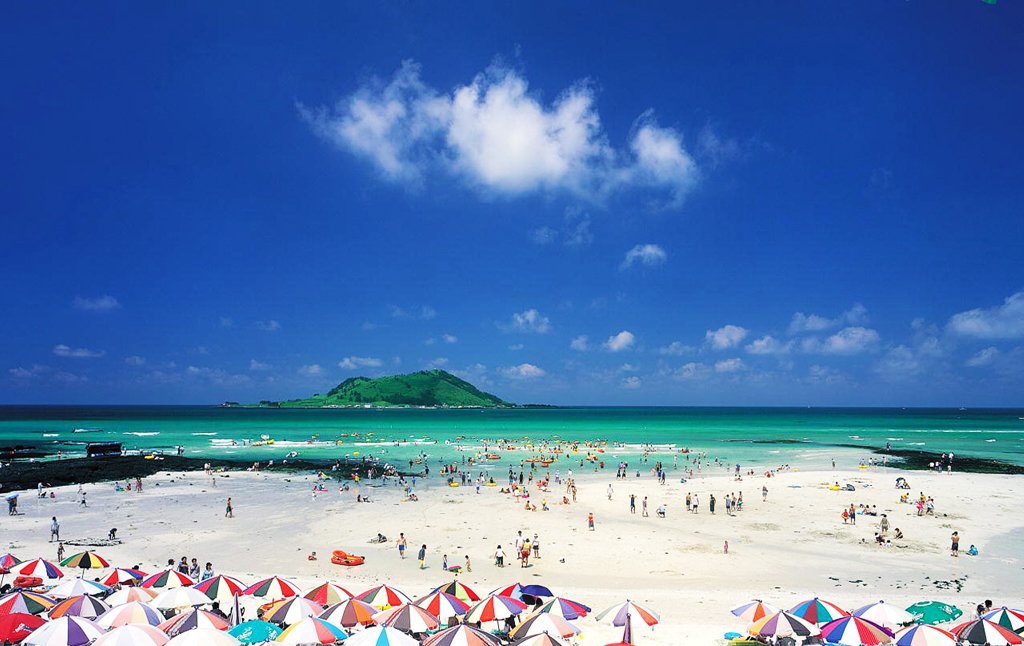
Hyeopjae Beach is one of Jeju Island’s most picturesque destinations, renowned for its stunning white sands and crystal-clear turquoise waters.
Located on the west side of the island, near Hallim Park, this beach stretches out invitingly and is lined with a backdrop of lush pine trees, adding a refreshing green contrast to the bright sand and blue sea.
The shallow waters near the shore are ideal for swimming, making it a perfect spot for families and casual swimmers alike.
The beach is also known for its beautiful views of Biyangdo Island, which rises majestically off the coast.
The natural scenery and the serene environment make Hyeopjae a quintessential spot for relaxation and photo opportunities, capturing the essence of Jeju’s coastal beauty.
Benefits of Visiting in September
September is an ideal time to visit Hyeopjae Beach for several reasons. Firstly, the summer crowds have thinned out significantly, allowing for a more peaceful and personal experience.
Visitors can enjoy long, uninterrupted stretches of sand without the hassle of finding a spot among throngs of tourists.
This decreased foot traffic makes September a prime time for those seeking tranquility and space to unwind.
Additionally, the weather in September is still warm enough to enjoy the beach, but not oppressively hot as in the peak summer months.
The temperate climate allows for all-day outings without the discomfort of high summer temperatures.
The sea remains warm from the summer sun, providing pleasant swimming conditions.
Visiting Hyeopjae Beach in September also coincides with some of the most scenic sunsets of the year, with the sun dipping directly into the horizon of the ocean.
This magical view complements the calm atmosphere, making evenings at Hyeopjae unforgettable.
The combination of fewer crowds, enjoyable weather, and stunning natural beauty underscores why Jeju Island is considered the best island to visit in September.
4. Experience Seongsan Ilchulbong
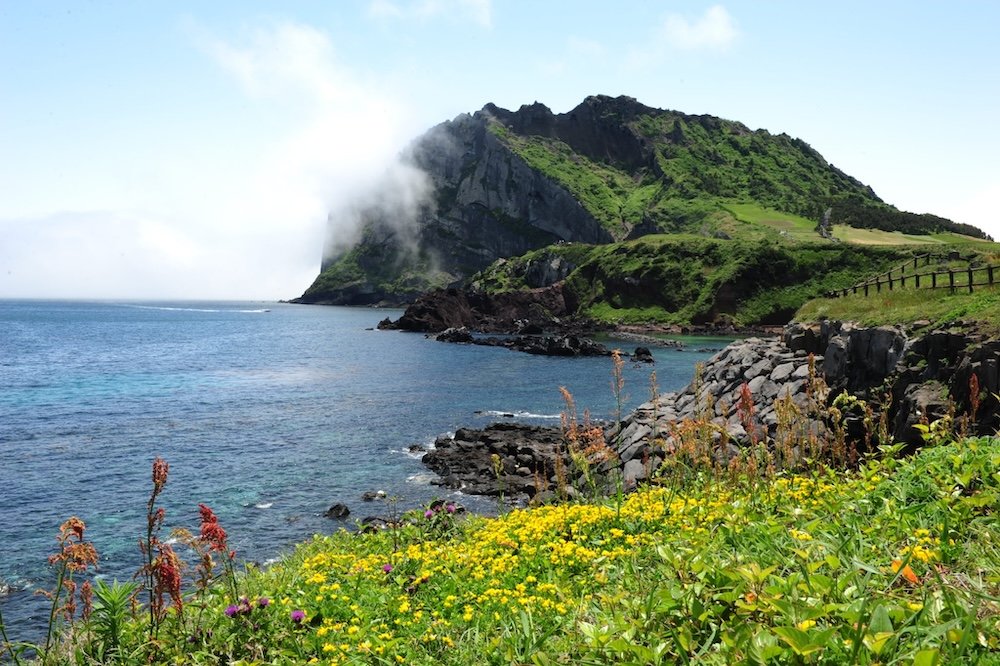
Seongsan Ilchulbong, also known as Sunrise Peak, is a UNESCO World Heritage site that dominates the landscape of Jeju Island’s eastern shore.
This geological wonder is a tuff cone formed by hydrovolcanic eruptions over 5,000 years ago.
Its distinctive crown-like shape and the verdant slopes rising 182 meters above sea level make it a stunning natural landmark.
The summit offers panoramic views of Jeju Island, the vast ocean, and the surrounding countryside, which are especially breathtaking at sunrise when the sun seems to rise directly from the sea.
The site is not only a marvel of natural history but also a testament to the island’s volcanic origins, adding depth to the visitor’s understanding of Jeju’s unique landscape.
The climb to the peak involves a well-maintained wooden staircase, making the ascent accessible to most fitness levels.
Tips for Visiting and the Significance of September
Visiting Seongsan Ilchulbong requires some planning to fully appreciate its beauty.
For the best experience, aim to arrive early in the morning to catch the sunrise.
This is the spectacle for which Seongsan Ilchulbong is most famous.
The climb takes approximately 20 to 30 minutes, so visitors should factor in this time to ensure they reach the summit before dawn.
September offers several advantages for visiting this iconic site.
Firstly, the weather is generally clear and mild, providing optimal conditions for hiking and photography.
The clear skies enhance the chances of an unobstructed view of the sunrise, which is not as guaranteed during the more overcast or rainy seasons.
Moreover, September is outside of Jeju’s peak tourist season, which peaks in summer and winter.
Visitors in September will encounter fewer crowds, making the experience more enjoyable and personal.
The reduced number of tourists also means less waiting time and more space at the summit to find the perfect spot for sunrise viewing.
Additionally, the natural scenery around Seongsan Ilchulbong is particularly vibrant in early autumn.
The surrounding vegetation begins to show autumnal hues, and the air is refreshingly crisp, enhancing the overall experience of the visit.
For those contemplating the best island to visit in September, Seongsan Ilchulbong on Jeju Island offers a compelling blend of natural beauty, manageable crowds, and favorable weather conditions, making it a must-visit destination.
5. Walk through Manjanggul Cave
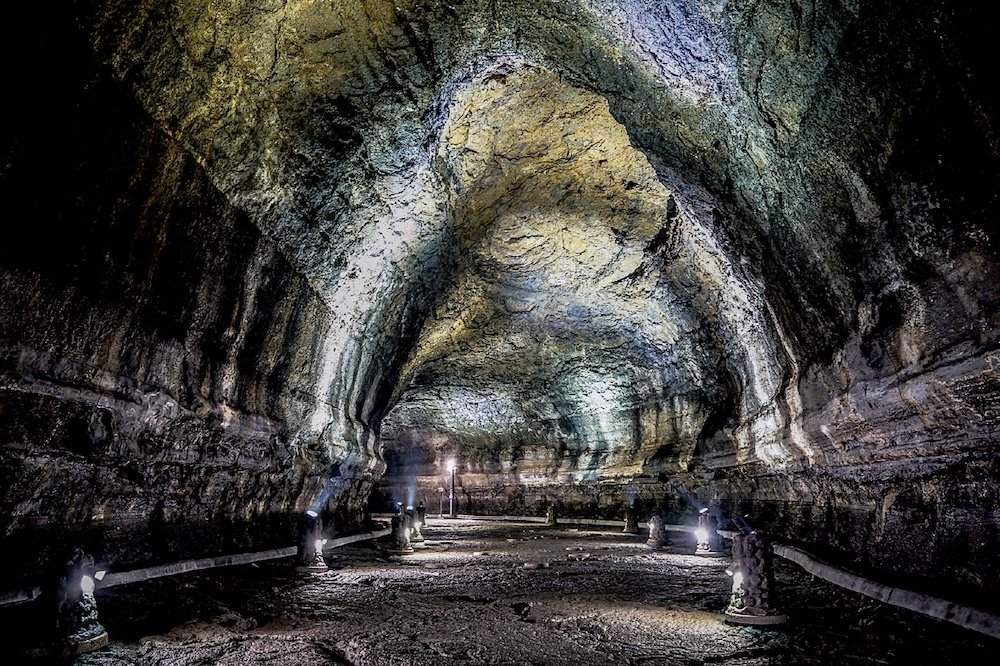
Manjanggul Cave, one of the finest lava tunnels in the world, offers a fascinating glimpse into Jeju Island’s volcanic geology.
This UNESCO World Natural Heritage site is a long lava tube that was formed over 200,000 years ago during volcanic eruptions that shaped much of the island’s current landscape.
Stretching for approximately 8.928 kilometers, with public access allowed to just about 1 kilometer, the cave features spectacular formations including stalactites, stalagmites, and the famous lava column, standing at 7.6 meters high—one of the tallest of its kind in the world.
The internal environment of Manjanggul is a testament to the powerful natural forces that continue to mold Jeju Island.
The tunnel is an excellent example of a well-preserved basaltic lava tube, showcasing various volcanic features and phenomena, such as lava flow lines and lava rafts, which are essential for understanding the geological history and development of Jeju.
Visitor Information Specific to September
September is an advantageous time to visit Manjanggul Cave for several reasons.
First, the cave maintains a constant temperature of about 11-21°C year-round, which makes it a perfect escape from the outside temperature fluctuations—especially the warm and transitional early autumn weather of Jeju.
This natural air-conditioning provides a refreshing break from the heat, with the added allure of exploring a geological marvel.
During September, the operating hours for Manjanggul Cave are typically from 9:00 AM to 6:00 PM, with the last admission at 5:00 PM.
These hours are subject to change, so visitors are advised to check the latest information before planning their trip.
The cave is well-prepared to accommodate tourists with sufficient lighting and paved paths, making the walk both safe and enjoyable.
Moreover, September’s lower tourist volume ensures a less crowded experience, allowing for a more leisurely exploration of the cave.
Visitors can take their time to appreciate the intricate details of the lava formations without the rush and noise of peak tourist seasons.
Tours are available, and they provide insightful commentary on the cave’s formation, features, and its significance in the broader context of Jeju’s volcanic activity.
For travelers considering the best island to visit in September, Manjanggul Cave on Jeju Island offers a unique and cool diversion from the typical beach and mountain activities.
It’s an ideal spot for those interested in geology, nature, or simply looking for a unique experience that combines adventure with the comfort of a constant cool climate.
6. Discover Jeongbang Waterfall
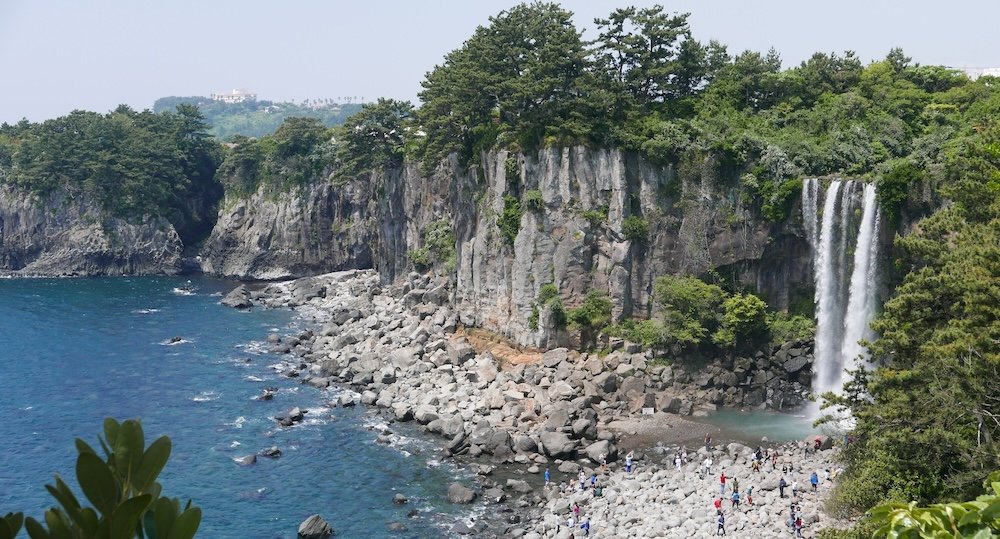
Jeongbang Waterfall is one of Jeju Island’s most extraordinary natural attractions and is often cited as the only waterfall in Asia that falls directly into the ocean.
Standing 23 meters high, the waterfall cascades over a verdant cliff directly into the sea, creating a spectacular and rare sight that encapsulates the raw beauty of Jeju’s volcanic landscape.
The sound of the water crashing into the waves below, coupled with the scenic backdrop of the ocean, makes Jeongbang Waterfall a breathtaking and memorable destination.
The area around the waterfall is rich in legend, adding a layer of cultural depth to its natural beauty.
According to local folklore, the waterfall is associated with the three demigods who are believed to have established the Tamna Kingdom, Jeju’s ancient governing body.
This adds a mystical element to visits, as one can not only enjoy the stunning views but also connect with the local mythology and history.
Best Viewing Practices in September
September is an excellent month to visit Jeongbang Waterfall for several reasons.
The weather during this month is typically mild and clear, providing ideal conditions for photography and sightseeing.
The comfortable temperatures make it pleasant for visitors to spend time exploring the surroundings without the discomfort of the summer heat or the unpredictability of late autumn weather.
During September, the waterfall is often at a moderate flow, which is perfect for viewing the water’s descent into the ocean without the spray being too overwhelming.
Visitors can access viewpoints from both the top of the cliff and the base near the sea, offering different perspectives of the waterfall’s beauty.
These vantage points are accessible via well-maintained trails that are less crowded in September, allowing for a more relaxed and intimate experience.
Visitors to Jeongbang Waterfall in September should plan to visit either in the early morning or late afternoon to avoid the brightest midday sun, which can create harsh shadows in photographs.
The soft light of morning or late afternoon enhances the natural colors of the scene, making these times ideal for capturing the beauty of the waterfall with the ocean in the background.
Given its unique characteristics and the optimal conditions present in September, Jeongbang Waterfall stands out as a must-visit location on Jeju Island.
It perfectly illustrates why this island is considered the best to visit in September, offering visitors a mix of natural wonder, cultural significance, and idyllic weather.
7. Visit the Jeju Teddy Bear Museum

The Jeju Teddy Bear Museum, a delightful attraction on Jeju Island, offers a unique and charming experience for visitors of all ages.
Opened in 2001, the museum is home to an extensive collection of teddy bears from around the world, including antique bears that date back to the early 20th century and modern, pop-culture-inspired creations.
The museum creatively displays these bears in various settings, depicting historical events, famous works of art, and scenes from popular culture, all reimagined with teddy bears as the main characters.
The museum’s exhibits are spread across several themed sections, including the “History Hall,” where teddy bears are dressed in period costumes to illustrate different eras; the “Art Hall,” showcasing bears as figures in famous paintings; and the “Project Exhibition Hall,” which features special exhibitions and contemporary teddy bear art.
This whimsical approach not only makes the museum a fun visit but also provides an educational twist, making it engaging for both children and adults.
Why It’s a Perfect Rainy-Day Activity in September
Visiting the Jeju Teddy Bear Museum is particularly ideal as a rainy-day activity in September.
As the month can occasionally bring showers, having an entertaining indoor option like the Teddy Bear Museum ensures that your travel plans remain uninterrupted by weather.
The museum’s indoor setting provides a cozy refuge from the rain, allowing visitors to leisurely explore the exhibits without the hurry that outdoor attractions might necessitate under inclement weather.
The warm and inviting atmosphere of the museum offers a cheerful contrast to the gloomy weather outside, making it a perfect place to spend a few hours.
The museum also features a café where visitors can relax with a drink or snack surrounded by the quaint charm of teddy bears, adding to the overall enjoyable experience.
Moreover, September’s slightly off-peak tourist season means that the museum is less crowded, allowing for a more comfortable and intimate viewing of the exhibits.
This makes it easier to appreciate the intricate details and creativity involved in each display without the distraction of large crowds.
For those wondering why Jeju Island is considered the best island to visit in September, the Jeju Teddy Bear Museum adds to the list with its unique cultural offering that provides a fun, educational, and weather-proof activity for all visitors.
8. Explore the Jeju Olle Trails
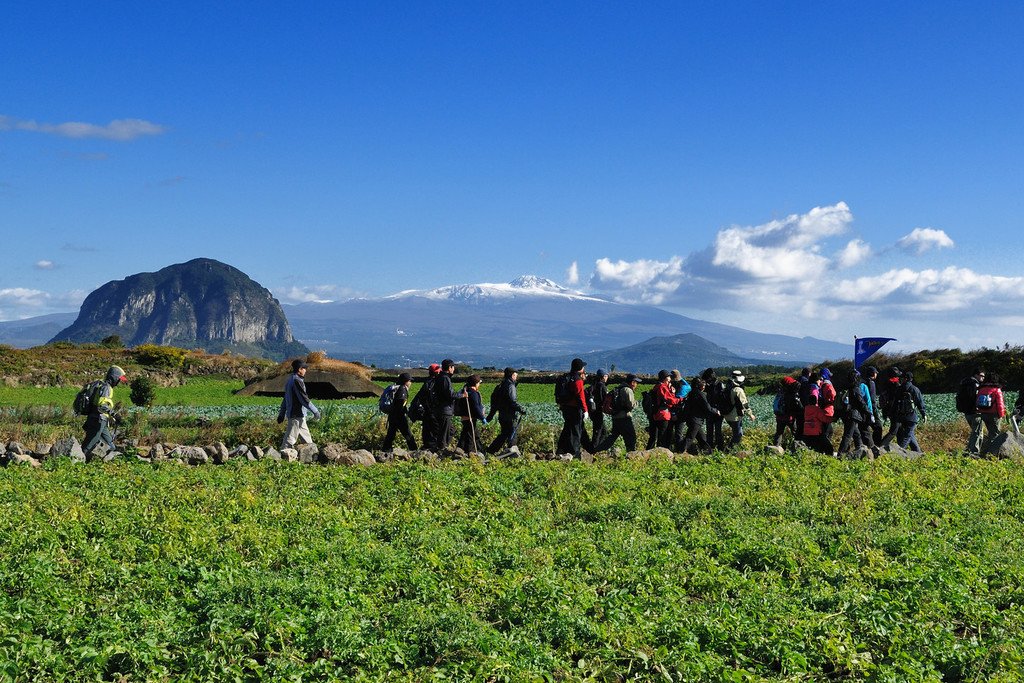
The Jeju Olle Trails are a network of walking paths that offer an immersive way to explore the diverse landscapes of Jeju Island.
These trails, inspired by the famous Camino de Santiago in Spain, were established to connect the natural, historical, and cultural attractions scattered across the island.
The network comprises over 20 routes, each uniquely showcasing different aspects of Jeju, from rugged coastlines and tranquil villages to verdant forests and volcanic craters.
Each trail is marked with blue and orange ribbons, ensuring that walkers can easily find their way.
The paths vary in difficulty and length, accommodating everyone from casual walkers to seasoned hikers.
As you walk these trails, you’ll encounter a variety of local wildlife, traditional thatched houses, and panoramic views of the island’s stunning scenery, making each step a discovery.
Why September’s Weather Makes It Ideal for Exploring These Trails
September is arguably the best time to explore the Jeju Olle Trails due to the ideal weather conditions.
The intense heat and humidity of the summer months begin to dissipate, replaced by cooler, more comfortable temperatures.
This mild climate is perfect for hiking, as it reduces the risk of heat exhaustion and makes physical activity more enjoyable.
Additionally, September often brings clear, sunny days, which are ideal for capturing the beauty of Jeju’s landscapes in photographs.
The visibility is excellent, offering unobstructed views of the island’s volcanic formations, lush greenery, and the expansive ocean.
The reduced rainfall during this month also means that the trails are less muddy and slippery, making for safer and more pleasant hiking conditions.
The temperate weather of September not only enhances the physical comfort of hiking but also enriches the sensory experience.
As you traverse the Olle Trails, the slightly cooler air carries the fresh scents of the sea and forest, and the changing colors of the foliage begin to hint at the approaching autumn.
9. Enjoy Local Cuisine at Jeju Markets

Jeju Island’s markets are vibrant hubs of activity and culture, providing a window into the local lifestyle and culinary traditions.
Among these, Dongmun Market stands out as a particularly popular destination. Located in the heart of Jeju City, this bustling marketplace has been a central part of local life since its opening in 1945.
Dongmun Market features an array of stalls selling everything from fresh seafood and produce to clothing and souvenirs.
However, it is most renowned for its wide selection of fresh, local foods that reflect the unique culinary landscape of the island.
The market is organized into several sections, each dedicated to different types of goods.
The food sections are particularly enticing, offering a chance to sample Jeju’s famous seafood, harvested from the surrounding waters, along with a variety of agricultural products grown in the island’s fertile volcanic soil.
Visiting Dongmun Market is not just about shopping; it’s an experience that engages all the senses.
Recommendations for Seasonal Food and Drinks to Try in September
September is an excellent time to explore the culinary delights of Jeju Island, as many seasonal foods are at their peak.
One of the must-try dishes is Jeju’s black pork, known for its juiciness and distinctive flavor, which can be enjoyed at one of the market’s many barbecue stalls.
Another local favorite is abalone porridge, a comforting dish that showcases Jeju’s abundant seafood.
For those with a taste for something lighter, the local hallabong, a type of seedless mandarin orange, begins to come into season in September and can be enjoyed fresh or in various desserts.
Jeju’s markets also offer a selection of fresh seafood like mackerel and hairtail, which are best enjoyed grilled or in stews.
Don’t forget to try some of Jeju’s traditional beverages as well.
Omegi-tteok, a sweet rice cake paired with mugwort tea, is a delightful combination to enjoy after a meal.
Another popular choice is Jeju’s green tea, made from leaves grown on the island’s mineral-rich volcanic soil, offering a refreshing and aromatic finish to any market visit.
10. Dive into Jeju’s Haenyeo Culture
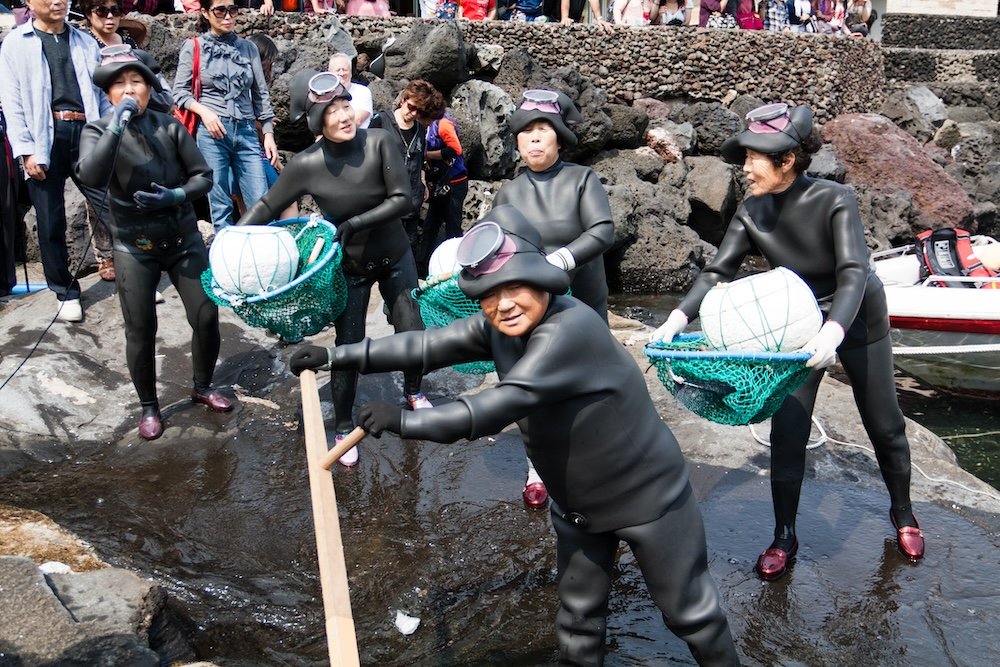
Jeju Island is not only famous for its natural beauty but also for its unique cultural heritage, particularly the haenyeo, or female divers, who are part of a centuries-old tradition that has been recognized by UNESCO.
These divers, many of whom are elderly women, dive into the ocean without oxygen tanks to gather shellfish, seaweed, and other marine life.
Learn at the Haenyeo Museum
To truly understand and appreciate the significance of this tradition, visitors can attend the Haenyeo Diver Show, which demonstrates their diving skills and techniques in a safe, controlled environment.
Additionally, the Haenyeo Museum offers exhibits on the history, culture, and lifestyle of these incredible women, providing insight into their daily routines and the challenges they face.
This experience not only offers a unique glimpse into a matriarchal profession but also allows visitors to engage with a dying tradition that continues to define Jeju’s cultural landscape.
Visiting in September offers the added advantage of pleasant weather, making outdoor and water-related activities more enjoyable.
Conclusion
Jeju Island emerges as an exceptional destination in September, offering a unique blend of cultural richness, natural beauty, and favorable climatic conditions.
Throughout this article, we’ve explored the top ten reasons why visiting Jeju during this month is particularly rewarding.
From the majestic vistas atop Hallasan Mountain to the vibrant traditions alive at local festivals, September presents a perfect window to experience the best of Jeju.
The moderate weather in September is ideal for outdoor activities, making excursions like hiking the Olle Trails or exploring the Seongsan Ilchulbong more enjoyable and comfortable.
This month also offers the chance to experience Jeju without the peak season crowds, allowing for a more relaxed and personal exploration of the island’s attractions.
Whether it’s walking through the tranquil Manjanggul Cave, watching a sunset at Hyeopjae Beach, or delving into the island’s culinary delights at Dongmun Market, each activity is enhanced by the pleasant September weather.
Moreover, the cultural events and festivals during September provide a deeper insight into the traditions and community spirit of Jeju, making it not just a visit but an immersive experience.
From sampling seasonal local cuisine to participating in cultural celebrations, there is no shortage of ways to engage with the island’s heritage.
To make the most of your visit in September, plan your itinerary to include a mix of outdoor adventures, cultural experiences, and leisurely explorations.
Embrace the slower pace of the off-peak season to fully absorb the beauty and tranquility of Jeju.
This approach not only enriches your travel experience but also connects you more closely with the landscape and culture of this remarkable island.
Jeju Island, with its September allure, is indeed the best island to visit during this month, offering an unforgettable escape that combines adventure, relaxation, and cultural discovery in one captivating setting.
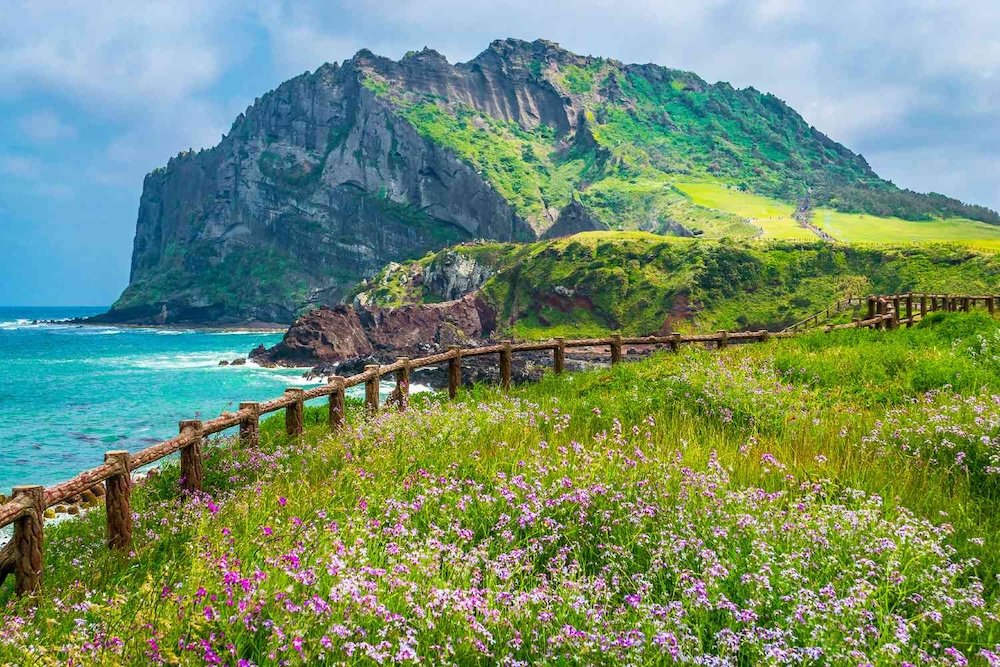
Additional Information
Practical Tips for Travelers in September
When planning a trip to Jeju Island in September, consider the following tips to enhance your travel experience:
- Weather Considerations: September in Jeju is generally mild with average temperatures ranging from 18°C to 26°C (64°F to 79°F). However, it is always wise to check the weather forecast close to your travel dates as occasional rain can occur. Packing a light waterproof jacket or an umbrella is advisable. For hiking or walking the trails, comfortable footwear and layered clothing will help you adjust to changes in weather throughout the day.
- Transportation: Renting a car is highly recommended for exploring Jeju Island as it offers flexibility to visit various attractions at your own pace. Public transportation is available but can be less convenient for reaching some of the more secluded sites.
- Accommodation: Booking your accommodation in advance is advisable, especially if you are visiting around the Chuseok holiday when many locals travel. Staying in different parts of the island can minimize travel times and allow for a more in-depth exploration of local areas.
- Cultural Etiquette: When visiting cultural sites and participating in festivals, showing respect for local customs and practices is important. For example, it’s polite to remove shoes before entering traditional homes or certain indoor venues.
COVID-19 Travel Restrictions and Guidelines
As of the last update, Jeju Island has been open to international travelers with few restrictions related to COVID-19.
However, travelers are encouraged to stay informed about potential travel advisories and any new health protocols that could be reinstated due to changing global health landscapes.
It’s recommended to check with airlines and the local embassy’s travel advisories close to your travel date.
- Health and Safety Measures: While on the island, continuing to practice good hygiene and being mindful of your health and others’ can help maintain a safe environment for everyone. This includes frequent hand washing and using hand sanitizer when soap and water are not readily available.
- Vaccination and Testing: Keeping up-to-date with your vaccinations, including COVID-19, can be a part of your travel preparations. Check if any health certificates or negative COVID-19 tests are required for entry or certain activities on Jeju Island.
By keeping these practical tips and guidelines in mind, travelers can enjoy a safe and fulfilling trip to Jeju Island in September, making the most of all that the island has to offer during one of its most enchanting months.
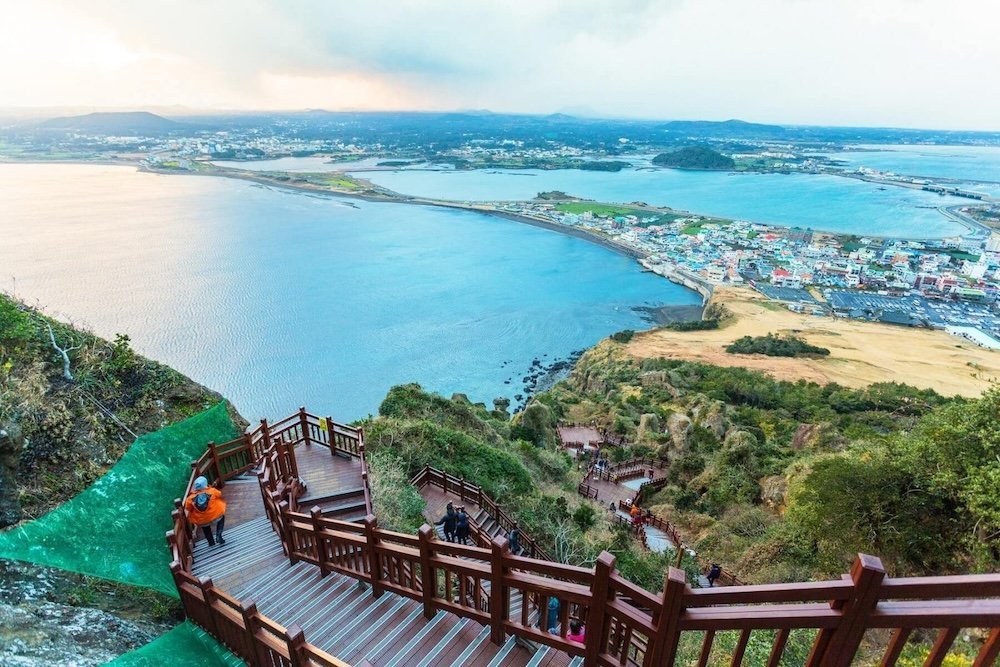
FAQ’s About Jeju Island:
Why is Jeju Island so famous?
Jeju Island is famous for its unique volcanic landscapes, beautiful beaches, and lush countryside.
It features a range of natural attractions including Hallasan, the highest mountain in South Korea, a UNESCO World Heritage Site, and the Jeju Volcanic Island and Lava Tubes.
Additionally, the island’s distinct culture, represented by the Jeju haenyeo (female divers recognized by UNESCO), adds to its fame.
How many died on Jeju Island?
The tragic events known as the Jeju Uprising or Jeju Massacre that occurred from 1948 to 1949 resulted in a significant loss of life.
Estimates vary, but it is generally believed that between 14,000 to 30,000 people died during this period, which was approximately 10% of the island’s population at the time.
Is Jeju Island touristy?
Jeju Island is a popular tourist destination both for domestic and international travelers, making certain areas quite touristy, especially around major attractions like Jeju City, Seongsan Ilchulbong, and the various beach resorts.
However, there are still many places on the island that offer quiet, unspoiled natural beauty for those seeking a more peaceful experience.
Is Jeju Island expensive?
The cost of visiting Jeju Island can vary widely depending on travel style.
While there are options for luxury accommodations and dining which can be quite expensive, there are also many budget-friendly choices available in terms of food, lodging, and activities, making it accessible for a range of budgets.
How many days in Jeju Island is enough?
Most travelers find that 3 to 5 days are sufficient to see the major highlights of Jeju Island, including visiting its natural parks, beaches, and cultural sites.
Those who wish to explore more thoroughly or engage in activities like hiking or diving may prefer to stay longer, up to a week.
What foods are famous in Jeju?
Jeju is renowned for its seafood, particularly abalone, sea urchins, and mackerel.
Black pork and Jeju mandarin oranges are also famous.
Traditional dishes include hairtail fish stew, Jeonbokjuk (abalone porridge), and Omegi-tteok (sweet rice cakes).
What is the best time to visit Jeju?
The best time to visit Jeju Island is during the spring (April to June) and autumn (September to November) months when the weather is mild and the scenery is at its most beautiful.
These periods also avoid the heavy tourist traffic of summer and the cold winds of winter.
Can I swim in Jeju Island?
Yes, Jeju Island is well-known for its beautiful beaches with clean and relatively safe waters, making it great for swimming.
Popular beaches like Hyeopjae, Hamdeok, and Jungmun are perfect for swimming, especially during the warmer months from June to early September.
How long does it take to go from Jeju to Seoul?
The flight from Jeju to Seoul typically takes about 1 hour and 10 minutes.
This is the most common and efficient way to travel between the two locations as there is no bridge or ferry service directly connecting Jeju Island to the mainland.
How do I get to Jeju Island?
Jeju Island can be reached by air with direct flights from various cities in South Korea and select international locations.
The island’s Jeju International Airport is well-connected, particularly with multiple daily flights from Seoul.
Additionally, there are ferry services available from mainland ports such as Busan and Mokpo.
How do you get around Jeju?
The most convenient way to get around Jeju is by renting a car, as public transportation options do not cover all tourist sites extensively.
There are buses that operate around the island, but they can be infrequent. Taxis are also available and can be a good option for shorter distances or if not renting a car.
How long does it take to walk around Jeju Island?
Walking around the entire perimeter of Jeju Island would be a considerable endeavor as the Jeju Olle Trail, which circles much of the island, covers approximately 425 kilometers.
Completing the entire trail on foot could take around 2 to 3 weeks, depending on the pace of walking and the amount of time spent at various sites along the way.





